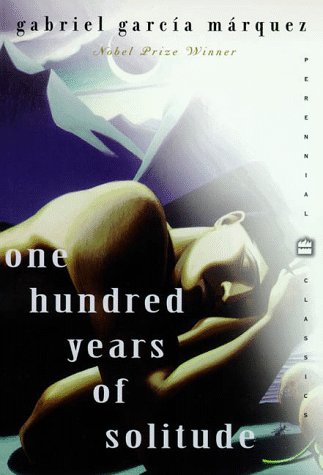One Hundred Years of Solitude
“Thinking that it would console him, she took a piece of charcoal and erased the innumerable loves that he still owed her for, and she voluntarily brought up her own most solitary sadnesses so as not to leave him alone in his weeping.”
What an adventure this book was. It took me a full year to get through it, because halfway through I got so confused as to who the characters were, I just had to put it down. Still, the writing called me back. Gabriel Garcia Marquez is a true master of language, knowing how to paint rich landscapes with words, and I can never stay away for long. This is the kind of book you will find yourself reading aloud many times, and even putting the book down in shock, due to its sheer poetic genius.
One Hundred Years of Solitude is the story of one family, told over many generations within a span of a hundred years. The only complaint I have, the only thing I’d change, is the character names. For some reason, Marquez decided to give each family member virtually the same name. After three generations of Arcadios and Aurelianos, it’s nearly impossible to keep them straight, and a tiny part of the romance is lost. I’ve included a chart below which shows the sheer ridiculousness of it. The fact that a detailed family tree exists on the internet, to me, is proof of the absurdity of it. I can’t tell you how many times I wanted to go through with myriad highlighters just to keep the characters straight.

That unfortunate tibdbit aside, if you can accept the fact that you don’t have to know everyone’s exact position in the family line, or which Aureliano is which, the story itself is full of gorgeous imagery the likes of which I’ve never seen in another author. Marquez has a method of storytelling that skirts the boundary of real and make believe. The selected quote above is a good example of this: “Thinking that it would console him, she took a piece of charcoal and erased the innumerable loves that he still owed her for.” Marquez means to imply that she literally took a piece of charcoal, and erased the figurative debt of love. Things that don’t really make sense suddenly take on a very real existence: Ghosts wander the streets and have conversations with townsfolk; It rains flowers for days, until the streets are so thick with the blooms no one can leave the house; and when someone dies the trail of blood winds down the street and into the kitchen of the victim’s mother as she cooks the family dinner.
This writing style is called “Magic realism,” and is also found in such writers as Jeanette Winterson, Toni Morrison and Frida Kahlo. Marquez is the master, in part because, “In Mexico,” he says, “surrealism runs through the streets. Surrealism comes from the reality of Latin America.”
Marquez’s writing certainly has all the workings of being based in magic. His work comes from an era where authors had to rely on the art of words, avoiding the tricks today’s writers tend to use (Palahnuik comes to mind, with his intentional misuse of words). Marquez’s explosive imagination, dedication to his art, and sheer talent have made him one of the most loved writers in Mexico, and worldwide. Simply put, if Marquez were a painter, One Hundred Years of Solitude would be his Sistine Chapel.
Read it here for free!
